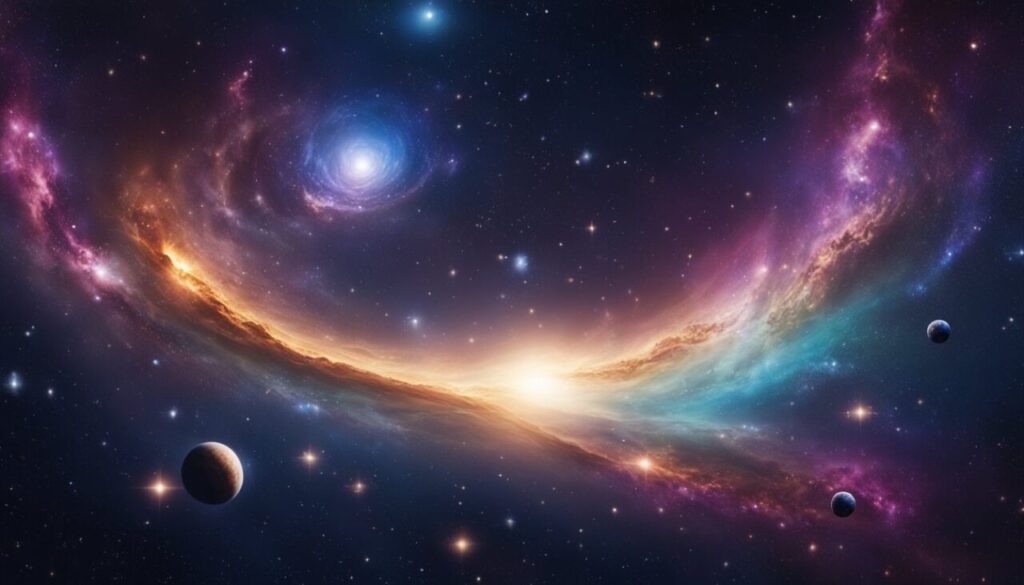
The concept of dimensions is frequently discussed in the field of physics, particularly when exploring the nature of the universe.
Additionally, different dimensions of reality and the universe have been part of many science fiction books and movies. Just take a look at the great movie Interstellar and you’ll notice how the creators are using five dimensions in a very smart and interesting way.
But just how many dimensions are there in the universe?
While the idea of dimensions may seem abstract and difficult to comprehend, it is a crucial part of understanding the fabric of the universe.
And our reality for that matter.
To begin with, it is important to understand what is meant by the term “dimension.”
So, let’s start. Let’s dive into each possible dimension.
Interesting fact: In string theory, the vibrational modes of fundamental strings can only consistently exist in spacetimes with a specific number of dimensions, typically ten, suggesting an interesting interplay between the microscopic structure of particles and the macroscopic geometry of the universe.
Understanding Dimensions

Basically, the concept of dimensions is used to describe the structure of the universe. In physics, there are two types of dimensions: spatial dimensions and temporal dimensions.
Spatial Dimensions
Spatial dimensions are the dimensions of space that we are most familiar with. They describe the length, width, and height of objects in our three-dimensional world.
Interesting fact: Some theories in physics propose the existence of additional spatial dimensions beyond the three we experience, but these dimensions are thought to be too small to be observed directly.
Temporal Dimensions
In simple terms, the fourth dimension is a concept used to describe a dimension beyond our everyday experience of three-dimensional space.
We live in a three-dimensional world where we can move forward/backward, left/right, and up/down.
The fourth dimension is described as time.
While we can move freely in the three spatial dimensions, time is considered the fourth dimension because it represents the continuum in which events occur, allowing for change and progression.
However, that’s not all. In different “deep” subfields of physics, there could be many more dimensions.
So, let’s explore those.
Interesting fact: The concept of time as a dimension was first proposed by the German mathematician Hermann Minkowski, in 1908.
What Are The 11 Dimensions?

According to the M-theory, there are actually 11 dimensions in the universe. These dimensions are not spatial, but they are rather different ways of looking at the universe.
The first four dimensions are the three dimensions of space (length, width, and height) and time. As mentioned, these dimensions are essential for defining an object’s position and motion in space-time.
The remaining six (+1 special) dimensions are curled up or compactified, meaning they are so small that they cannot be detected through traditional means.
These dimensions are referred to as Calabi-Yau manifolds and are believed to be responsible for the fundamental forces of nature.
The Calabi-Yau manifolds have different shapes and sizes, and each shape determines the properties of the particles that exist in that dimension.
For instance, the shape of the Calabi-Yau manifold in the sixth dimension determines the properties of the electron.
And so let’s “see” all of those dimensions in a simple table:
| Dimension | Type | Description |
| 1 | Time | The dimension through which events unfold and which we perceive as the progression of time. |
| 2 | Space (x) | The first spatial dimension represents length or distance along a line. |
| 3 | Space (y) | The second spatial dimension represents width or distance across a surface. |
| 4 | Space (z) | The third spatial dimension represents height or distance through a volume. |
| 5 | Compactified | A dimension that is curled up or compactified at extremely small scales, beyond observation. |
| 6 | Compactified | Another dimension similarly compactified, often visualized as wrapped up in a tiny loop. |
| 7 | Compactified | A third compactified dimension, usually too small to be observed directly. |
| 8 | Compactified | A fourth compactified dimension, part of the compactification process in string theory. |
| 9 | Compactified | A fifth compactified dimension, theorized to be imperceptibly small and curled up. |
| 10 | Compactified | A sixth compactified dimension, involved in the Calabi-Yau manifold, a mathematical construct. |
| 11 | Brane | A higher-dimensional object, such as a membrane or “brane,” where string theory plays a role. |
So everything is clear now?
Huh, not really. Not even close. Nobody actually understands all those dimensions and M theory is strictly that – a pure theory.
But it gets even more complicated than that.
What Are 26 Dimensions?

Originally, string theory was proposed in 26 dimensions to ensure mathematical consistency.
However, it was later found that a version of the theory in 10 dimensions, known as superstring theory, provided a more promising framework for describing the universe.
Superstring theory incorporates supersymmetry, a theoretical symmetry between particles with integer and half-integer spin, which helps resolve certain issues in particle physics.
The shift from 26 dimensions to 10 (or 11 depending on which theory you use) dimensions occurred largely due to the realization that certain inconsistencies arose in higher-dimensional formulations.
And while the idea of 26 dimensions may seem ultra-overwhelming, it is important to note that these dimensions are not all equal.
In fact, as mentioned, only three of these dimensions are considered to be large and visible, while the other 23 are thought to be compactified and hidden from view.
One potential explanation for the existence of these extra dimensions is that they are necessary for the mathematical consistency of string theory.
Without them, the equations that describe the behavior of strings would not make sense.
However, once again, this is all purely theoretical. Only a few people on Earth can somehow explain these deep fields of theoretical physics.
Edward Witten is certainly one of them.
Okay, okay – so let’s just stop for a minute.
Namely, we’ve started with 3 dimensions, then added time, then added 6 or 7 other dimensions and now we’re somehow already “talking” about 26 dimensions?
That sounds crazy?!
Well, that’s why there are many different theories inside string theory. And many physicists argue which theory is the best.
So we mentioned already some of those theories or sub-theories, but let’s summarize them in one place.
So How Many String Theories Are There?

Well, as far as we know – there are 5. But hereby we will stick with the three most prominent ones.
Those are:
- Bosonic String Theory: This theory treats fundamental particles as one-dimensional “strings” rather than point-like particles. In bosonic string theory, the fundamental strings vibrate in spacetime, giving rise to different particles. However, it’s limited because it only describes bosons (particles with integer spin) and requires spacetime to have 26 dimensions for mathematical consistency.
- Superstring Theory: This theory extends bosonic string theory by incorporating fermions (particles with half-integer spin), allowing it to describe both bosons and fermions consistently. Superstring theory requires spacetime to have 10 dimensions for mathematical consistency. It introduces supersymmetry, a symmetry between bosons and fermions, which could provide a solution to some long-standing problems in particle physics.
- M-Theory: M-theory is an extension of superstring theory that incorporates higher-dimensional objects called “branes.” It unifies the different string theories by showing that they are different manifestations of a single underlying theory. M-theory requires spacetime to have 11 dimensions. It’s still a subject of ongoing research and is considered a candidate for a theory of everything, aiming to unify all fundamental forces and particles in one framework.
So basically (if this word could be even used in this complex context), everything revolves around mathematical consistency.
One theory needs 26 dimensions to be consistent with math while others need 10 or 11.
But could there be something more? Perhaps more dimensions or theories?
Well, let’s entertain this idea also.
Are There Infinite Dimensions?

As already mentioned, in some theories, such as M-theory, there are propositions that suggest the existence of more than three spatial dimensions.
These extra dimensions are often compactified or curled up in such a way that they are not directly observable at human scales.
And the number of these dimensions can vary depending on the specific theory being considered.
As for whether there could be an infinite number of dimensions, it’s a speculative question that’s still an area of active research and debate.
Some theories entertain the possibility of an infinite number of dimensions, while others propose a finite number or even a discrete set of dimensions.
If we move away from pure theoretical physics then we’re also arriving at the point of possibility for infinite dimensions.
Namely, the notion of infinite dimensions often arises in certain branches of mathematics, particularly in areas like functional analysis, Hilbert spaces, and certain types of geometry such as fractal geometry.
In mathematics, a Hilbert space is a generalization of the concept of Euclidean space to an infinite-dimensional setting. These spaces play a fundamental role in various areas of mathematics and physics, particularly in quantum mechanics.
In a Hilbert space, the notion of dimensionality is extended to an infinite number of dimensions, and vectors can have an infinite number of components.
Fractal geometry is another area where the concept of infinite dimensions comes into play. Fractals are geometric shapes that exhibit self-similarity at different scales.
They can have fractional or even non-integer dimensions, leading to the idea of “fractional dimensions” or “fractal dimensions.” These dimensions provide a way to quantify the complexity and irregularity of fractal objects.
Then, in cosmology, some models of the universe, such as certain versions of inflationary cosmology, suggest the possibility of a multiverse with an infinite number of dimensions or universes.
And so, today, we don’t have any empirical evidence to conclusively prove or disprove the existence of an infinite number of dimensions.
But certainly, in the next 100 or 1000 years we will know much more about the number of dimensions in the universe.
And so that raises another question.
Could Other Beings Live Among Us In Other Dimensions?

Well, this is a rather interesting concept.
While there is no concrete evidence to support this claim, some theories suggest that there could be parallel universes or alternate dimensions that we are not aware of.
One theory suggests that there could be multiple universes, each with its own set of physical laws and dimensions. These universes would exist alongside our own and could potentially contain other forms of life that are adapted to their respective environments.
In some multiverse theories, the extra dimensions are thought to be the source of the energy that drives the expansion of the universe, known as dark energy.
Another implication of extra dimensions for multiverse theories is the possibility of explaining the fine-tuning problem, which is the apparent fine-tuning of the physical constants of the universe that allow life to exist.
In theories with extra dimensions, the physical constants can vary in different universes, and our universe may just happen to have the right values for life to exist.
We’ve written a lot about similar topics in the following articles:
And again, currently, there are no conclusive evidence about any kind of beings living among us but in other dimensions.
But that does not mean they do not exist. Perhaps we only don’t have senses that are capable of seeing through dimensions where particular beings could exist.
Interesting fact: The concept of parallel universes was first introduced in 1954 by physicist Hugh Everett III.
And so, is there any way to find proof of higher dimensions?
Let’s see.
Evidence of Higher Dimensions

Experimental Searches
Scientists have been conducting many different experiments in an attempt to detect evidence of higher dimensions. One such experiment is the Large Hadron Collider (LHC), which is a particle accelerator located in Switzerland. The LHC has been used to search for evidence of extra dimensions by looking for the production of microscopic black holes. However, so far, no evidence of extra dimensions has been found.
Another experiment is the Alpha Magnetic Spectrometer (AMS), which is a particle physics detector located on the International Space Station.
The AMS has been used to search for evidence of dark matter, which is thought to exist in higher dimensions.
However, while the AMS has detected excess positrons, which could be a sign of dark matter, it is still unclear whether these excess positrons are actually caused by dark matter.
Interesting fact: The LHC is the largest machine in the world, with a circumference of 27 kilometers.
Cosmological Observations
Cosmologists have also been studying the universe in an attempt to detect evidence of higher dimensions.
One way they do this is by studying the cosmic microwave background (CMB), which is radiation left over from the Big Bang.
By analyzing the CMB, cosmologists can look for patterns that could be caused by the influence of higher dimensions.
Another way cosmologists search for evidence of higher dimensions is by studying the distribution of galaxies in the universe.
If there are extra dimensions, it is possible that gravity could leak into them, causing the distribution of galaxies to look different than it would in a universe with only three dimensions.
Interesting fact: The cosmic microwave background was discovered by accident in 1964 by two Bell Labs scientists who were trying to eliminate noise from their radio antenna.
Conclusion

And finally, at the end of the article do we have a conclusive answer?
How many dimensions are there in the universe?
No, unfortunately, we don’t have the final answer. No, one does – at least not with the clear proof or any kind of evidence for that matter.
In summary, the exploration of dimensions in the universe is a multi-layered effort that goes through both theoretical physics and speculative concepts in science fiction.
From the foundational understanding of spatial and temporal dimensions to the complex theories of string theory and beyond, the concept of dimensions serves as a some kind of keystone in our search to comprehend the nature of reality.
While theories like M-theory propose the existence of 11 dimensions and beyond, including compactified dimensions and branes, the mathematical consistency of these theories remains a problem.
Moreover, the possibility of infinite dimensions raises additional questions about the fundamental structure of the universe, with implications extending into cosmology and multiverse theories.
Despite the absence of (any kind of) empirical evidence for higher dimensions, ongoing experimental searches, such as those conducted at the Large Hadron Collider and through cosmological observations, continue in their search for tangible proof.
Will we ever have the proof?
No one can say with 100% certainty for now, but surely next decades will bring some interesting findings that will perhaps completely change our understanding of basic physics and the complexity of the universe.
We’ve been waiting for years and years for something like that to happen.
Remember, most theoretical physics frameworks are still based on the works of people who lived 100 years ago or more.



























